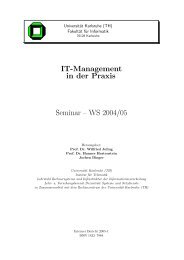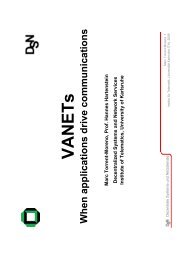Download PDF - KIT
Download PDF - KIT
Download PDF - KIT
You also want an ePaper? Increase the reach of your titles
YUMPU automatically turns print PDFs into web optimized ePapers that Google loves.
Following the control-theory perspective discussed in Section<br />
III, awareness control protocols can be classified as<br />
open-loop or closed-loop approaches, and can use implicit<br />
or explicit feedback. Different existing open-loop awareness<br />
control protocols use power-range maps to dynamically adapt<br />
each vehicle’s transmission power as a function of its transmission<br />
range requirements. For example, the work in [30]<br />
proposes an OPportunistic-driven adaptive RAdio resource<br />
Management (OPRAM) mechanism, that adapts each vehicle’s<br />
transmission parameters to reliably and efficiently exchange a<br />
message before reaching a critical safety area, for example an<br />
intersection. The OPRAM mechanism is an application-driven<br />
awareness control protocol that is based on radio propagation<br />
estimates to dynamically calculate the required transmission<br />
power levels as a function of the distance to the critical safety<br />
area. Despite having been designed as a power-range map<br />
based technique, OPRAM could be evolved to dynamically<br />
adapt the transmission power and packet generation rate to<br />
the experienced channel load, in order to compensate for<br />
the negative effects of packet collisions on the application’s<br />
reliability. OPRAM will be described in detail in the next<br />
section.<br />
Multi-hop beaconing protocols represent an alternative<br />
open-loop solution for awareness control. With these protocols,<br />
broadcast messages transmitted by a vehicle are relayed<br />
by neighboring vehicles to achieve the target probability of<br />
reception at high distances within the required delay. In [31],<br />
the Multi-Hop Vehicular Broadcast (MHVB) protocol is intended<br />
to efficiently relay broadcast packets over multiple<br />
hops, and satisfy the target dissemination area within the<br />
allowable latency. With MHVB, only the vehicle that correctly<br />
receives a given broadcast message and is located at the<br />
highest distance from the transmitter will relay such message.<br />
A similar approach was proposed in [32], where a vehicle can<br />
relay multiple beacons during its lifetime in a single packet<br />
as long as it has received each one of these beacons less<br />
than a established maximum number of times. With multihop<br />
beaconing protocols, the beacon’s transmission power<br />
was able to be reduced compared to single hop beaconing<br />
protocols. In this context, the work in [33] compares singlehop<br />
and multi-hop beaconing protocols. This study shows<br />
that under simplified propagation and multi-hop operating<br />
conditions, the channel load in multi-hop beaconing protocols<br />
can be reduced using packet multiplexing techniques. With<br />
these techniques, when a vehicle has to relay a broadcast<br />
packet it will attach its own broadcast packet to the relayed<br />
message. However, in realistic environments where packets<br />
can be lost due to radio channel errors and packet collisions,<br />
the reduction of the channel load obtained with multi-hop<br />
beaconing cannot be achieved. It is worth mentioning that,<br />
in scenarios where obstacles block the radio signal, such as<br />
buildings or trucks, multi-hop beaconing protocols could be<br />
required to successfully satisfy the application requirements.<br />
Closed-loop awareness control protocols make use of exchanged<br />
broadcast messages to dynamically adapt to the varying<br />
propagation and channel load conditions. In some existing<br />
solutions, the feedback is implicitly obtained from received<br />
messages without the need to transmit extra information. An<br />
example of closed-loop solution with implicit feedback is the<br />
work in [34], in which the authors propose the use of the<br />
received messages to estimate in real-time the path loss or<br />
average signal attenuation, by subtracting the power estimated<br />
at the receiver from the transmitted power (included by default<br />
in the header of all beacons in cooperative vehicular systems).<br />
The proposed algorithm dynamically selects the power and<br />
data rate required to successfully transmit a packet to a given<br />
vehicle, while minimising the interference generated to other<br />
vehicles. In the joint rate-power control algorithm proposed<br />
in [23], two different control approaches are applied to adapt<br />
the packet generation rate and the transmission power. In order<br />
to detect abnormal driving maneuvers in advance, the packet<br />
generation rate is dynamically adapted to bound the longitudinal<br />
and lateral position tracking errors of surrounding vehicles.<br />
A new packet is transmitted when the estimated tracking<br />
error of surrounding vehicles exceeds a certain threshold. To<br />
estimate the tracking error, the algorithm takes into account<br />
the channel reliability by dynamically estimating the packet<br />
error probability from the packets received from surrounding<br />
vehicles. The transmission power is adapted based on the<br />
observed channel status. Considering Lmin and Lmax as<br />
the lower/upper transmission range bounds dictated by the<br />
safety applications, the transmission range is linearly adapted<br />
between Lmin and Lmax as a function of the experienced<br />
channel load. The transmission power is then calculated considering<br />
power-range maps based on empirical measurements.<br />
Other closed-loop awareness control solutions are based on<br />
explicit feedback. In this case, vehicles inform each other<br />
about the correct reception of messages at a certain distance.<br />
Using this explicit information, vehicles can decide whether<br />
they should increase or decrease their transmission power<br />
and/or packet generation rate. For example, the work in [35]<br />
includes the target range of the packet, and the IDs of the<br />
nodes from which a message was successfully received when<br />
their separation distance was larger than the target range, as<br />
extra information in the beacon’s header. When a vehicle<br />
receives more than N beacons containing its ID, it decreases<br />
its transmission power, since at least N vehicles beyond the<br />
target range are receiving its broadcast messages. This type of<br />
closed-loop technique depends heavily on the correct reception<br />
of a beacon to adequately adapt its operational parameters.<br />
As a result, if some of these messages are not correctly<br />
received, for example due to packet collisions under high<br />
traffic densities, the vehicles can incorrectly increase their<br />
transmission power and augment packet collisions.<br />
The accuracy or precision of the awareness information<br />
received from surrounding nodes is also analysed in different<br />
protocols proposed in the literature. A representative example<br />
is reported in [16], where the authors propose an openloop<br />
approach through which the packet generation rate is<br />
dynamically adapted to bound the tracking errors of surrounding<br />
vehicles. To this end, a new packet is transmitted by a<br />
vehicle only when its movement changes (speed, heading,<br />
etc.). In this case, the authors propose that each of these<br />
packets be retransmitted several times to ensure its reception<br />
by surrounding vehicles, which results in a decrease of the<br />
tracking error in realistic propagation environments, at the<br />
10




